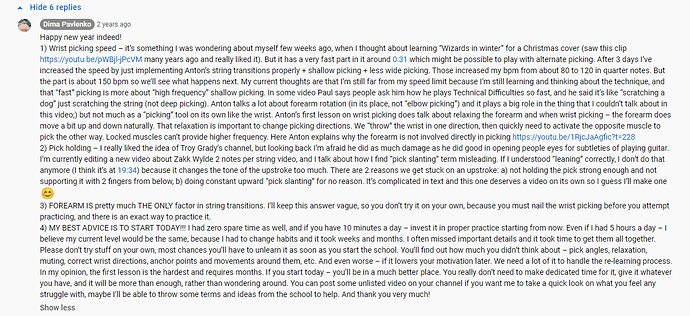So a number of thoughts on Anton’s approach and potential things to practice here.
First - for 3 NPS alternate picking - there are 4 basic patterns that come from 2 parameters
ASC/DESC direction (ascending or descending), and starting Up/Down stroke. So we get 4 six note patterns varying each parameter. However, we aren’t maintaining exact form since we’re anchored so we have to consider the following.
Anchoring the palm at a fixed point
This gives a consistent reference point - Anton’s student here talks about choosing the correct height of the hand. Cross referencing Anton’s other video with a student, that would indicate that I was roughly correct in saying we balance the end of the Ulna near the top of the bridge where the strings emerge. I think the stable point is actually touching the tip of the ulna to the top of the bridge and resting the forearm on the body of the bridge.
Why so specific?
If you rest on the front of the bridge, you won’t have as much forearm stability (my arm tries to pronate more) and you won’t be able to clear the lowest strings with respect to muting, which would contradict one of Anton’s points in his video as far as having full control of muting.
Because you are anchored - this means your form will tend to alter moving up and down the fretboard - there are 6 (or in my case 7) strings. The number of vertical positions to play a six note, 2 string pattern = 6 -1 = 5.
This gives a total of 5x4 = 20 patterns to verify are consistent.
In addition, we are looking for muting, so double that for 40 patterns to verify - muted and unmuted. Certainly a lot of patterns, but a very finite number that will cover all transitions of 3 NPS alternate picking.
To verify the positioning is correct - you should be able to play all of these positions and variations with and without muting. Importantly - you will need a DBX motion to play all of the base 4 patterns. I don’t know 100% what Anton’s escape techniques are - but following the principle of using one muscle for one job as literally as possible, we can still use wrist extension - but only on string changes. So, potentially - if you develop escapes by practicing the above 4 basic patterns with the escape mechanic in play (wrist extension or flexion but only introduced on string changes) you would be adding a single muscle on either downstroke escape if you’re primary USX or upstroke escape if you’re primary DSX, rather than on every upstroke and downstroke. This should be significantly more efficient than maintaining 902 the whole time and you can see in the videos he does not do that.
Pick Grip Construction (supplied by student in this video)
- The pick is no thinner than .8 MM
- The pick is perpendicular to the thumb
- The less fleshy portion towards the tip of the thumb pad or towards the side of the thumb can be used
- The pick is against the DIP joint of the index finger
- The DIP joint of the middle finger reinforces the DIP joint of the index
Anton starts his students out on the G string, playing with strong picking and dynamics, and pushing through the string. This should be mastered on the G string then transferred to heavier strings.
To accomplish this, he uses the above pick grip approach, where the pick is stable and is pinched between hard surfaces while being ergonomic.
So perhaps, practicing the 4 six note patterns, using 802 with 902 for escapes on downstroke, and starting on the G/B strings then progressing, would be a valid approach to this once you have a stable pick grip.
@Tom_Gilroy

 He made no mention of an alternative but told me he’d put me on a waiting list and if and when stuff gets lifted, he’ll let me know.
He made no mention of an alternative but told me he’d put me on a waiting list and if and when stuff gets lifted, he’ll let me know.




